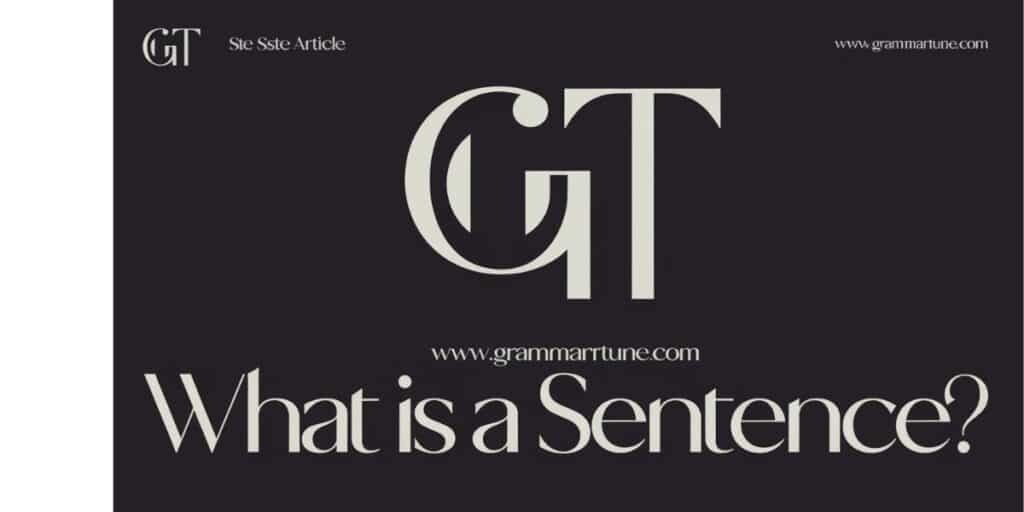What do you understand about the term ‘Sentence’? A sentence is really much more than a collection of words; it is a fundamental building block of all communication. It gives meaning, emotion, and intent.
A proper understanding of how sentences work is most necessary for clear and effective communication.Whether you’re writing an essay, texting a friend, or delivering a speech, the focus keyword ‘sentence’ will ever be important in framing how and what ideas are presented
It is made of a subject, a verb, and often an object. Still, it can even become very complicated to present extensive details in different contexts. Mastery of structuring sentences is an important part of developing perfect communication skills.
What Is a Sentence? – Meaning and Definition
A sentence is a bunch of words that articulate complete thought. It has a subject and a predicate. In English, sentences are either simple or clause-bound, depending on their structure.
It may or may not stand alone. Its content specifies that it sometimes needs further elaboration for one’s complete understanding. It serves to express meaning, whether in questioning, stating, or commanding.
Formation of Sentences in English
English sentence formation basically describes a given structure, which is subject + verb + object. In “She reads books”, there is a simple combination.
Keeping this structure in mind provides a foundation for forming sentences that are clear and direct.” As these become more complex, further adjuncts, in the form of modifiers, will also need to be added. Mastery of these adjuncts allows for more complex sentence constructions.
Parts of a Sentence
A sentence is generally broken down into the subject, predicate, and sometimes an object. The subject usually specifies which or whom the sentence speaks about. The predicate specifies what the subject does or is.
In a complex structure, a basic subject and predicate are cast into a variety of expansions whereby phrases or clauses are added. This serves the purpose of unifying these parts into delivering a coherent message.
Components of a Sentence
The three principal elements in a sentence are subject, verb, and object. While the subject represents the
or topic, the verb denotes the action. Objects are the receivers of the action in some sentences. Adjectives and adverbs are among other components that add information to these basic building blocks. These add-ons help in embellishing whatever is being said in the sentence. .
Types of Sentences
A declarative sentence merely states a fact; an interrogative sentence asks a question. So there are four types of sentences: declarative, interrogative, imperative, and exclamatory. The command is given by the imperative, while the exclamatory gives expression to deep feelings.
Each type of sentence serves its own purpose and follows its own structure. Knowing the differences only helps improve one’s ability to speak and write.
Punctuation of Sentences
Tips for Punctuating Sentences: Punctuation Is a Must for Clear Sentences: Periods, question marks and exclamation marks are the three commonly used marks to punctuate a sentence at the end and inform the reader what tone the sentence is cast in.
Further, commas and semicolons help separate ideas within a sentence or clauses. Clear punctuation must also prompt consideration for how a reader understands the intended meaning of a sentence.
Examples of Sentences
Sample sentences could include; “I like coffee,” “Are you coming?”, “Please sit down,” and “Wow, that’s amazing!” Each sentence serves a different function, thus illustrating the various types of sentences.
These sentences are representative of the ways in which a language can convey simple statements, ask questions, give orders, or express feelings. Taking time to analyze these is the first step in becoming able to write sentences.
Check Your Understanding of Sentences and Their Formation
Identify the subject and predicate of the various types of sentences to test your knowledge. In fact, it is a practice to broaden your understanding of how sentences are constructed by knowing the significance of each of these parts.
With practice in sentence analysis, therefore, you will cultivate a better understanding of the formation of sentences. With this heightened understanding, you will find writing and speech more spontaneous.
Latest from Taxmann
Taxmann presents to you latest and relevant updates on sentence structure, contributing undeniably to an in-depth appreciation of its significance in communication.
Whoever you are-whether a student, a professional, or simply someone wishing to gain a bit of polish on his or her writing-name it-and these resources shall walk you toward mastering-a forever, for sure-the art of Build-the-Sentences.
Thus is a brief account of The Latest from Taxmann focusing on every part of the sentence-their usage and rules. They range from definition to classification so as to unleash the full potential of your writing skills.
Definition of a Sentence
A sentence is a collection of words that indicate a full thought. Usually a sentence has a subject and a verb and can be either a statement, question, command, or exclamation. The primary goal of a sentence is to make an idea very clear.
Essentially, a sentence is the bedrock of language. It arranges words into meaningful units of communication, thus permitting activity in all the many forms of discourse.
Structure of a Sentence
The aim of the structure of a sentence is to arrange the set of words in a coherent way that intends to convey a clear message of meaning.
The arrangement is based on the structure that goes – subject + verb + object. This structure is further open to modification by adjectives, adverbs, or clauses.
A well-structured, effective sentence will allow for a clear path to impact the reader, while a poor example of a sentence structure can waver in its impact as the text becomes dense with more complex sentences.
Types of Sentences
All four sentence types-the declarative, the interrogative, the imperative, and the exclamatory-have different purposes. Differentiability has to be present in the user while they or she speaks or writes.
This classification system allows you to analyze and alter your tone and formality, depending on your communicative goals: to express information, to ask questions, to command something, or to create emotional appeal.
3.1 Classification According to Function
The classification of sentences can be performed according to function: declarative, interrogative, imperative, and exclamatory.
Each of these types fulfills its unique function. For instance, a declarative sentence states something about a particular state of affairs, whereas an interrogative sentence asks a question.
Classification by function helps to realize the communicative role of sentences as their usefulness for writing clarity and for deciding how one will adapt the message to context.
3.2 Classification According to Structure
Depending on the structures, further classification of sentences includes simple, compound, complex, and compound-complex sentences.
The simple sentence consists of an independent clause only, whereas, the compound sentence consists of two independent clauses connected by a conjunction.
Thus, if these classifications are used, the sentences could be far more varied and sophisticated-something that is of utmost importance for the fine-tuning of writing style and complexity.
3.3 Subject-Verb Agreement
There is an integral role played by Subject-verb agreement in grammar. This means that subjects and verbs conform with each argument on the count and person within a sentence.
For example, she now runs Singular Subject + Verb and runs now for plural subjects + verbs; and they run for singular.
To master subject verb agreement is paramount to achieve accuracy in grammar as well as in creating smooth and understandable sentences or sustaining the rules of English syntax.
Examples of a Compound Sentence
This is a sentence with two independent clauses joined with a coordinating conjunction: “and,” “but,” “or,” “yet,” or “so.” For example: “I wanted to go to the park, but then it started to rain.
In this case, they are joined by ‘but,’ which is the conjunction for joining both of these independent thoughts together.
With the help of compound sentences, an individual can incorporate many thoughts while preserving the inside structure of the sentence, correct and concise. They contribute to increasing the variation in the use of language to enhance its flow.
Sentence Construction in KS1
In KS1 children are included in the subject sentences. They study basic patterns, namely simple structures like subject + verb +object-and are taught simple examples: “The cat sleeps,” “I play soccer.”
These early lessons introduced young learners to the mechanism of sentences. Gradually, complex sentences are formed by combining adjectives, adverbs, and simple punctuation.
Sentence Construction in KS2
When a KS2 child starts developing an understanding of sentence structure, they go on to learn how to join together clauses to form gre on longer sentences with conjunctions such as ‘because’ or ‘although’.
I like pizza because it is delicious.” Students also learn about compound and complex sentence types so that they can hone their writing skills.
Resources for Teaching Children About Sentences
There is much information which may help you teach children sentences. Such resources include sentence formation interactive games, sentence-building worksheets, or online platforms available on the internet.
Teachers Pay Teachers does have many ready-to-use things, apps that do pretty well in helping students practice sentence making through fun activities online.
Using diverse resources, children will engage in different forms of sentence construction. Another very effective means are visual aids in the form of a sentence diagram.
The Four Types of Sentenc
Declarative, interrogative, imperative, and exclamatory are the four types of sentences. Each type is expected to achieve a very different purpose in communication.
In general, there are four types of sentences: the declarative sentences state information, the interrogative sentences bring forth a question, the imperative sentences give an order or direction, and exclamatory sentences convey emotion in an intense way.
Identifying the different forms of sentences helps to clarify expression, tone, and intention.These are often the critical forms that must be used when one speaks or writes.
The Subject Could Be Implied
In some cases, an implied subject serves in a sentence rather than directly stating it. For example, in saying “Sit down,” “you” is understood as the subject. The understanding of when a subject is implied is highly important for making appropriate sentences.
It frequently occurs that the subject in such sentences is usually implied from the listener or reader. This might be used to shorten and give more modality to the sentences.
The Four Sentence Structures
Types of sentences in English are four: Simple, Compound, Complex and Compound Complex. These different sentence types organize ideas in writing. In fact, it helps to keep writing more interesting.
All kinds of sentence structure apply to how you would deliver an idea: whether as simple statements or, for most, the complexity of joining several ideas.
(1) Simple Sentence
Simple sentences give one independent clause only and convey the full thought: for instance, “She sings well.” Simple sentences, however, are very important for the purposes of clear communication.
The Simple sentences are very easy to follow and form the building blocks to more complicated constructions. They are ideal for communicating uncomplicated ideas.
(2) Complex Sentence
There is a complex sentence made up of at least one independent clause and one dependent clause. For example: “Although it was raining, she went for a walk.” Over here, the dependent clause, “Although it was raining,” gives extra context.
In contrast, complex sentences lend a richness and variation to writing by allowing writers to specify additional information about their subjects.
(3) Compound Sentence
The compound sentence is made up of two independent clauses that are joined by a coordinating conjunction.
Such joins are: “I wanted to go to the beach but it was too cold.” This type of sentence joins two interrelated ideas.
Compound sentences help to clearly express more than one thought. They are necessary in different kinds of writing.
(4) Compound-Complex Sentence
Some independent clauses shall behave as singular in a compound-complex sentence with the presence of at least one dependent clause. “Although I was tired, I went for a run, and felt better afterward”.
The compound and complex sentences intermingle in this compound-complex sentence structure, thus making expressions rich and giving an artist more training wheels for writing and communication.
Why Understanding Sentences Is Important
Heard but not really heeded in school academic exercises are sentence constructions. Nevertheless, that is exactly the way with which one may employ language-an activity, an action, a procedure through which one may simply brighten anyone’s day.
Turmoil in thought becomes clearer with sentence proficiency, as it ensures systematically structuring thoughts whether in writing.
Conclusion
Effective communication relies on a basic understanding of a sentence. Clear comprehension of what is defined as a sentence in language makes it possible for someone to say something.
Speech is made up of structured thoughts, expressed clearly and accurately through sentences, be it in a simple or complex form. The various kinds of sentence structure would serve a specific purpose in making messages understood clearly and effectively.
Mastering sentence construction and knowing what type a sentence is will strengthen our skills in communication through the use of precision. It allows a person, at least, to start knowing what has to be uttered or written confidently. Knowing what a sentence is facilitates effective communication.
FAQ’S
What is a sentence?
A sentence is a group of words that expresses a complete thought.
What are the types of sentences?
The four main types are declarative, interrogative, imperative, and exclamatory.
What is a compound sentence?
A compound sentence combines two independent clauses with a conjunction.
What is a complex sentence?
A complex sentence has one independent clause and at least one dependent clause.
What are sentence parts?
The main parts of a sentence are the subject, verb, and often an object.
Why is sentence structure important?
Good sentence structure ensures clarity and effective communication.
What is subject-verb agreement?
Subject-verb agreement means the subject and verb must match in number and person.

Joulia, a seasoned wordsmith and grammar enthusiast, brings over a decade of blogging expertise to Grammar Tune. With a keen eye for linguistic precision and a passion for making complex grammar concepts accessible, he has helped thousands of readers enhance their writing skills. His engaging teaching style and practical approach to language learning have made him a trusted voice in the online grammar community.







